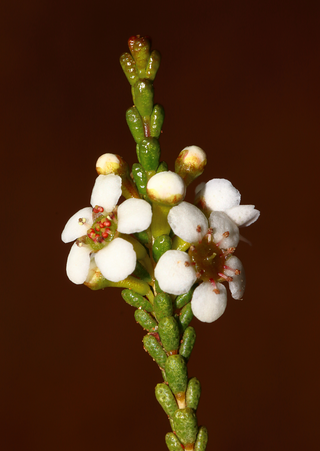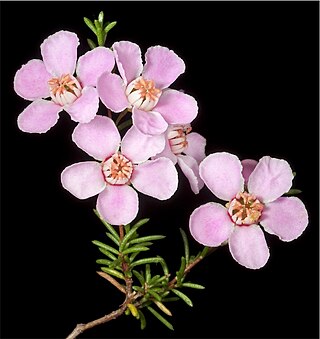
Agonis grandiflora is a species of flowering plant in the family Myrtaceae, and is endemic to the southwest of Western Australia. It is an erect, often straggly shrub with sessile, linear leaves, white flowers often suffused with pink and broadly cup-shaped capsules.

Melaleuca lecanantha is a plant in the myrtle family, Myrtaceae and is endemic to a small area of south-west Western Australia. It is a shrub with small, rather fleshy leaves and pink to lilac-coloured flowers in early spring. The plant was first described in 1867 but the name given to it was considered illegitimate and it was not until 1998 that it was first formally described.
Austrobaeckea pachyphylla is a species of flowering plant in the family Myrtaceae and is endemic to the south of Western Australia. It is a shrub with bilaterally flattened leaves and small white flowers with two to eight stamens.
Austrobaeckea pygmaea is a species of flowering plant in the family Myrtaceae and is endemic to the south-west of Western Australia. It is a slender and erect or spreading shrub with narrowly egg-shaped to almost linear leaves and small white flowers with 12 to 25 stamens.
Austrobaeckea uncinella is a species of flowering plant in the family Myrtaceae and is endemic to the south coast of Western Australia. It is a shrub with narrowly egg-shaped to linear leaves and small white flowers with seven to thirteen stamens.

Hypocalymma puniceum, commonly known as large myrtle, is a species of flowering plant in the myrtle family Myrtaceae, and is endemic to the south-west of Western Australia. It is a spreading shrub with linear leaves and bright pink flowers arranged singly in leaf axils, with 35 to 55 stamens in several rows.

Micromyrtus clavata is a species of flowering plant in the family Myrtaceae and is endemic to inland Western Australia. It is an erect, compact or sprawling shrub with erect, egg-shaped leaves with the narrower end towards the base and small white flowers arranged singly in upper leaf axils.

Micromyrtus elobata is a species of flowering plant in the myrtle family, Myrtaceae and is endemic to the south of Western Australia. It is usually an erect shrub with small, narrowly to broadly egg-shaped leaves with the narrower end towards the base, and white flowers 3–5 mm (0.12–0.20 in) in diameter.

Micromyrtus racemosa is species of the flowering plant in the family Myrtaceae and is endemic to the south-west of Western Australia. It is a shrub with relatively thick, narrowly egg-shaped leaves, sometimes with the narrower end toward the base, and white, cream-coloured or yellow flowers 2.5–4.0 mm (0.098–0.157 in) in diameter.

Babingtonia camphorosmae, commonly known as camphor myrtle, is a species of flowering plant in the family Myrtaceae and is endemic to the southwest of Western Australia. It is a prostrate to low-growing shrub with linear to thread-like leaves and white or pink flowers in groups of up to five, each flower with ten to thirteen stamens.

Babingtonia cherticola is a species of flowering plant in the family Myrtaceae and is endemic to the southwest of Western Australia. It is an erect shrub with linear leaves and white or pale pink flowers in groups of up to three, each flower with 16 to 26 stamens.
Babingtonia delicata is a species of flowering plant in the family Myrtaceae and is endemic to a small area in the southwest of Western Australia. It is a slender shrub with erect stems, linear leaves and bright pink flowers in groups of up to three, each flower with 4 to 8 stamens.
Babingtonia erecta is a species of flowering plant in the family Myrtaceae and is endemic to the southwest of Western Australia. It is an erect shrub with densely clustered, linear leaves and white or pale pink flowers in groups two to seven in leaf axils, each flower with 8 to 14 stamens.
Babingtonia fascifolia is a species of flowering plant in the family Myrtaceae and is endemic to the southwest of Western Australia. It is a shrub with erect, slender stems, linear leaves and white or pale pink flowers in groups two to seven in leaf axils, each flower with 19 to 23 stamens.
Babingtonia maleyae, commonly known as the Narrogin babingtonia, is a species of flowering plant in the family Myrtaceae and is endemic to the southwest of Western Australia. It is a compact shrub with narrowly egg-shaped to elliptic leaves and white flowers usually arranged singly in leaf axils, each flower with 17 to 20 stamens.
Babingtonia minutifolia is a species of flowering plant in the family Myrtaceae and is endemic to a small area in the southwest of Western Australia. It is an erect, widely spreading shrub with narrowly egg-shaped to elliptic leaves and pale pink flowers arranged singly in leaf axils, each flower with 16 to 19 stamens in a circle.

Babingtonia pelloeae, commonly known as Pelloe's babingtonia, is a species of flowering plant in the family Myrtaceae and is endemic to the southwest of Western Australia. It is an erect shrub with narrowly oblong to linear leaves and pink flowers usually arranged singly in leaf axils, each flower with 12 to 20 stamens in a circle.
Babingtonia triandra, commonly known as triplet babingtonia, is a species of flowering plant in the family Myrtaceae and is endemic to a restricted area of the southwest of Western Australia. It is a low, spreading to almost prostrate shrub with linear leaves and white flowers usually arranged in groups of up to 16 in leaf axils, each flower with 3 widely spaced stamens.
Babingtonia urbana, commonly known as coastal plain babingtonia, is a species of flowering plant in the family Myrtaceae and is endemic to the southwest of Western Australia. It is a shrub with linear leaves and white or pale pink flowers usually arranged singly in leaf axils, each flower with 16 to 20 stamens in a circle.

Thryptomene parviflora is a species of flowering plant in the family Myrtaceae and is endemic to Queensland. It is a slender, erect shrub with decussate, linear to egg-shaped leaves with the narrower end towards the base, and flowers with five petals and five stamens arranged singly in leaf axils.










